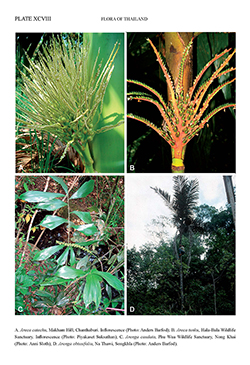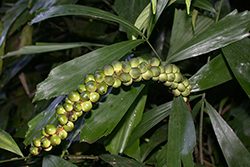e-Flora of Thailand
Volume 11 > Part 3 > Year 2013 > Page 334 > Arecaceae > Arenga
1. Arenga caudata (Lour.) H.E.Moorewfo-0000263554
Principes 4: 114. 1960; Thai Forest Bull., Bot. 32: 35. 2004.— Borassus caudatum Lour., Fl. Cochinch.: 2: 619. 1790.— Wallichia caudata (Lour.) Mart., Hist. Nat. Palm. 3: 315. 1853.— Blancoa caudata (Lour.) Kuntze, Revis. Gen. Pl. 2: 727. 1891.— Didymosperma caudatum (Lour.) H.Wendl. & Drude ex B.D.Jacks., Index Kew. 1: 756. 1893. Plate XCVIII: C.
Accepted Name : This is currently accepted.
Synonyms & Citations :
Description : Densely clustered shrub. Stem 0.6–2 cm diam. Leaves ca 10 in crown; sheath deeply split, with margins resolving in fibrous mesh, petiole 30–60 cm long; rachis to 60 cm long; lamina divided into 4–10 rhomboid to linear pinnae on each side, 20–80 by 2–10 cm, dark green, distinctly silvery grey below, apical margins praemorse. Inflorescences 2–3, interfoliar, developing in basipetal sequence, the most distal one usually female, the others male, spicate, or rarely with secondary branches, 25–30 cm long, curved. Fruit 1–1.5 cm diam., globose, orange to red, densely inserted.
Thailand : NORTH-EASTERN: Loei, Nong Khai, Sakon Nakhon, Nakhon Phanom, Khon Kaen; EASTERN: Nakhon Ratchasima, Ubon Ratchathani; CENTRAL: Saraburi, Nakhon Nayok; SOUTH-EASTERN: Sa Kaeo, Chon Buri, Chanthaburi; PENINSULAR: Chumphon, Ranong, Surat Thani, Phangnga, Phuket, Krabi, Nakhon Si Thammarat, Trang, Satun, Songkhla, Pattani, Yala, Narathiwat.
Distribution : Myanmar, Hainan, Cambodia, Laos, Vietnam (type), Peninsular Malaysia.
Ecology : Locally common in moist or wet forests throughout Thailand, from sea level to 700 m alt.
Vernacular : Tan (ตาล)(Central, Chon Buri); tan kai (ตาลไก้)(Loei); tan rang (ตาลรั้ง)(Chanthaburi); tao rang nu (เต่าร้างหนู)(Chanthaburi, Peninsular).
Uses: Ornamental.
Conservation Status: Widespread and of little concern.
Notes: Highly variable with several distinct leaf forms, differing in the degree of splitting and the width of the segments. May be conspecific with Arenga hookeriana (see notes there).


